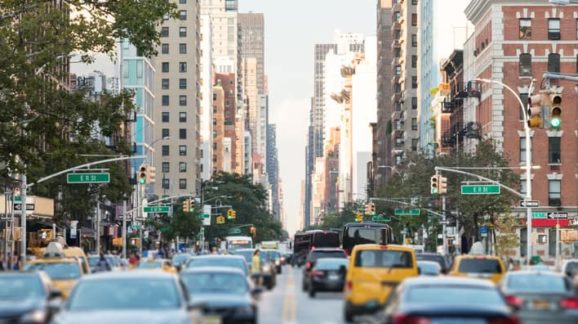Major Auto Companies Auto Dealers Back Trump Fuel Economy Rule

I testified today before the House Oversight Environment Subcommittee on the Trump administration’s Safer Affordable Fuel-Efficient (SAFE) Vehicles rule. I was the sole minority witness. In all, six witnesses testified, including former California Gov. Jerry Brown and Rhode Island Democratic Sen. Sheldon Whitehouse. You can watch the full hearing here.
Upon entering the minority staff office next to the hearing room, a colleague called my attention to a cheery piece published the night before in Reuters: “GM, Toyota, Fiat Chrysler back Trump on California emissions challenge.” The article begins: “Major automakers are siding with the Trump administration in its bid to bar California from setting its own fuel efficiency rules or zero-emission requirements for vehicles, the companies said in a filing with a U.S. appeals court late on Monday.” Mazda, Nissan, Kia Motors, and Suburu also joined the filing, as did the National Automobile Dealers Association.
NADA, by the way, has long been the lone industry voice decrying the Obama administration’s “triplification” of fuel economy regulation. Under the statutory scheme Congress created in 1975 and updated in 2007, the National Highway Traffic Safety Administration (NHTSA) prescribes and enforces fuel economy standards, the EPA tests automakers compliance with the standards, and the California Air Resources Board (CARB) kibitzes just like any other stakeholder. Then in spring 2009, Obama climate czar Carol Browner negotiated a “put nothing in writing, ever” deal that put three agencies in charge of regulating fuel economy (EPA, NHTSA, and CARB), under three statutes, through three sets of regulations.
The Reuters article opines that siding with Trump “could prompt a furious backlash from Democrats and environmentalists”—definitely—and suggests it could also backfire if a Democrat wins the White House in the 2020 election and “reinstates California’s right to set its own rules and tougher national emissions standards adopted by President Barack Obama.”
Easier said than done. As my written testimony argues, the legal case for defrocking California as a national fuel economy regulator is powerful. If Trump prevails in court, putting California back in the fuel economy driver’s seat would probably require an act of Congress.
The text of my oral testimony follows:
Chairman Rouda, Ranking Member Comer, and Members of the Subcommittee, thank you for inviting me to testify on the Safer Fuel-Efficient Vehicles rule.
About one month after the SAFE rule was proposed, The Washington Post ran an exposé claiming, or insinuating through the mouths of experts, that the rule is a plan to doom humanity to a future of planetary ruin: “Last month, deep in a 500-page draft environmental impact statement, the Trump administration made a startling assumption: On its present course, the planet will warm a disastrous 4 degrees Celsius by the end of the century.”
Actually, there was nothing startling about it. Four degrees of warming is what you get when you run EPA’s climate policy model—called MAGICC—with an assumed climate sensitivity of 3°C and a blend of the UN climate panel’s two higher emission scenarios, called RCP6 and RCP8.5. With minor technical updates, the Trump document uses the same methodology as the Obama administration. That was necessary to do an apples-to-apples comparison between the Obama policies and the SAFE rule.
What the Trump analysis actually shows is that replacing the Obama mileage standards with the SAFE rule would have vanishingly small impacts on greenhouse gas emissions, global temperatures, and sea level rise.
Specifically, compared to the Obama standards, the SAFE rule would add an extra three-thousandth of one degree Celsius to global average temperatures and six millimeters to sea levels in 2100.
Three thousandths of one degree is 27 times smaller than NOAA’s margin of error for measuring changes in global average temperature. So, the additional warming from the SAFE rule would literally be undetectable.
That miniscule warming increment would make no practical difference to weather patterns, coastal flooding, polar bear populations, or any other environmental condition people care about. In short, the policy change effected by the SAFE rule is climatologically irrelevant.
The Post did not mention that the Department of Transportation estimated that the SAFE rule would avoid $250 billion in auto industry compliance costs, $190 billion in auto fatalities and injuries, and $2,340 in higher average vehicle costs in 2025.
If the SAFE rule achieves only 10 percent of those benefits, or just makes new cars more affordable to low- and middle-income households, the rule makes good sense, for two reasons. First, new cars are safer, cleaner, and more fuel-efficient than older vehicles. Second, as just discussed, sticking with the Obama standards would have no discernible climate benefits.
Most of my written testimony deals with the SAFE rule’s preemption of California’s standards. To briefly summarize, the nation’s fuel economy statute, the Energy Policy Conservation Act, prohibits states from adopting or enforcing laws or regulations “related to” fuel economy. California’s standards are directly and substantially related to fuel economy. Consequently, the SAFE rule voids the standards. More importantly, it returns California to its pre-2009 status as stakeholder, rather than decision maker, in fuel economy regulation.
That big institutional reform will help ensure that the EPA and the Department of Transportation give due consideration to the potential adverse impacts of fuel economy standards on vehicle affordability, consumer choice, and occupant safety.